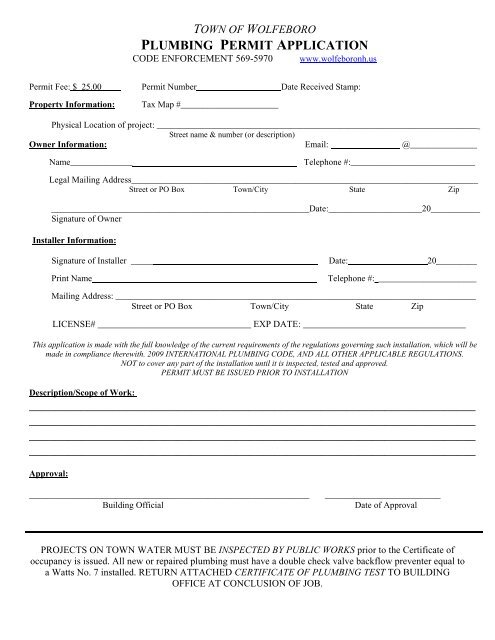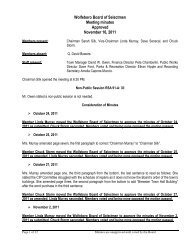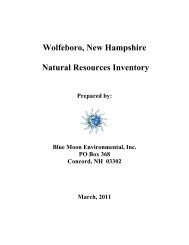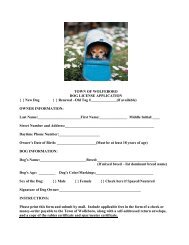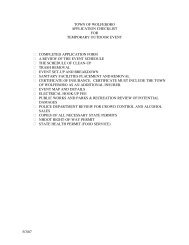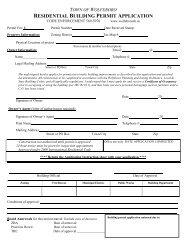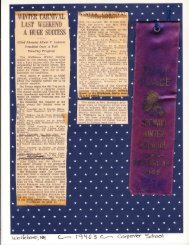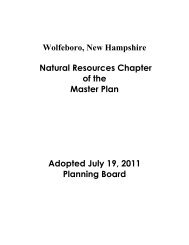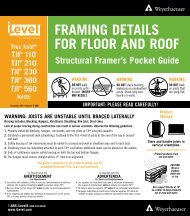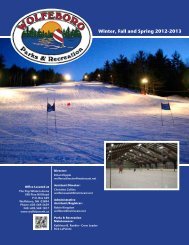PLUMBING PERMIT - Town of Wolfeboro
PLUMBING PERMIT - Town of Wolfeboro
PLUMBING PERMIT - Town of Wolfeboro
Create successful ePaper yourself
Turn your PDF publications into a flip-book with our unique Google optimized e-Paper software.
TOWN OF WOLFEBORO<br />
<strong>PLUMBING</strong> <strong>PERMIT</strong> APPLICATION<br />
CODE ENFORCEMENT 569-5970 www.wolfeboronh.us<br />
Permit Fee: $ 25.00 Permit Number Date Received Stamp:<br />
Property Information:<br />
Tax Map #______________________<br />
Physical Location <strong>of</strong> project: ________________________________________________________________________<br />
Street name & number (or description)<br />
Owner Information: Email: @_______________<br />
Name______________<br />
Telephone #:____________________________<br />
Legal Mailing Address_____________________________________________________________________________<br />
Street or PO Box <strong>Town</strong>/City State Zip<br />
__________________________________________________________Date:_____________________20__________<br />
Signature <strong>of</strong> Owner<br />
Installer Information:<br />
Signature <strong>of</strong> Installer _____ Date: 20 _________<br />
Print Name<br />
Telephone #: ______________________<br />
Mailing Address: _________________________________________________________________________________<br />
Street or PO Box <strong>Town</strong>/City State Zip<br />
LICENSE# _________________________________ EXP DATE: ___________________________________<br />
This application is made with the full knowledge <strong>of</strong> the current requirements <strong>of</strong> the regulations governing such installation, which will be<br />
made in compliance therewith. 2009 INTERNATIONAL <strong>PLUMBING</strong> CODE, AND ALL OTHER APPLICABLE REGULATIONS.<br />
NOT to cover any part <strong>of</strong> the installation until it is inspected, tested and approved.<br />
<strong>PERMIT</strong> MUST BE ISSUED PRIOR TO INSTALLATION<br />
Description/Scope <strong>of</strong> Work:<br />
_____________________________________________________________________<br />
_____________________________________________________________________<br />
_____________________________________________________________________<br />
_____________________________________________________________________<br />
Approval:<br />
_______________________________________________________________<br />
Building Official<br />
__________________________<br />
Date <strong>of</strong> Approval<br />
PROJECTS ON TOWN WATER MUST BE INSPECTED BY PUBLIC WORKS prior to the Certificate <strong>of</strong><br />
occupancy is issued. All new or repaired plumbing must have a double check valve backflow preventer equal to<br />
a Watts No. 7 installed. RETURN ATTACHED CERTIFICATE OF <strong>PLUMBING</strong> TEST TO BUILDING<br />
OFFICE AT CONCLUSION OF JOB.
TOWN OF WOLFEBORO<br />
CERIFICATE OF <strong>PLUMBING</strong> TEST<br />
CODE ENFORCEMENT 569-5970<br />
Property Information:<br />
Plumbing Permit # _____________<br />
_________________________________________________________________________________<br />
Property location/street address<br />
Plumber Information:<br />
Print Name____________________________________ Telephone #: __________<br />
Signature <strong>of</strong> Licensed Plumber<br />
N.H. License # _____________<br />
I hereby certify that the plumbing systems provided by the license holder above and under the plumbing permit number above are<br />
installed and tested in accordance with good trade practices and comply with current code for the <strong>Town</strong> <strong>of</strong> <strong>Wolfeboro</strong> and the State<br />
<strong>of</strong> New Hampshire.<br />
Plumbing test(s) initialed below were completed in accordance with IRC 2009 Chapter 25<br />
Test Plumber Initial Date tested<br />
P2603.4 Building sewer testing<br />
(see reverse side for details)<br />
P2503.5.1 Rough plumbing<br />
(see reverse side for details)<br />
(circle one test)<br />
Water test OR Air test<br />
P2503.5.2 Finished plumbing<br />
(see reverse side for details)<br />
Water tightness<br />
P2503.6 Water-supply system<br />
(see reverse side for details)<br />
P2503.7.2 Testing. Reduced<br />
pressure principle backflow<br />
preventers, double check valve<br />
assemblies, double-detector check<br />
valve assemblies and pressure<br />
vacuum breaker assemblies<br />
P2503.6 Shower liner test<br />
(see reverse side for details)<br />
Inspections Required:<br />
1.) After groundwork has been completed but PRIOR to backfilling<br />
2.) At the completion <strong>of</strong> rough-in <strong>of</strong> the DWV system and service lines<br />
3.) At Inspection for Certification <strong>of</strong> Occupancy
International Residential Code 2009 Chapter 25 Plumbing Administration<br />
SECTION P2501 GENERAL<br />
P2501.1 Scope. The provisions <strong>of</strong> this chapter shall<br />
establish the general administrative requirements<br />
applicable to plumbing systems and inspection<br />
requirements <strong>of</strong> this code.<br />
P2501.2 Application. In addition to the general<br />
administration requirements <strong>of</strong> Chapter 1, the<br />
administrative provisions <strong>of</strong> this chapter shall also apply<br />
to the plumbing requirements <strong>of</strong> Chapters 25through 32.<br />
SECTION P2502 EXISTING <strong>PLUMBING</strong> SYSTEMS<br />
P2502.1 Existing building sewers and drains.<br />
Existing building sewers and drains shall be used in<br />
connection with new systems when found by examination<br />
and/or test to conform to the requirements prescribed by<br />
this document.<br />
P2502.2 Additions, alterations or repairs. Additions,<br />
alterations, renovations or repairs to any plumbing<br />
system shall conform to that required for a new plumbing<br />
system without requiring the existing plumbing system to<br />
comply with all the requirements <strong>of</strong> this code. Additions,<br />
alterations or repairs shall not cause an existing system<br />
to become unsafe, insanitary overloaded.<br />
Minor additions, alterations, renovations and repairs to<br />
existing plumbing systems shall be permitted in the same<br />
manner and arrangement as in the existing system,<br />
provided that such repairs or replacement are not<br />
hazardous and are approved.<br />
SECTION P2503 INSPECTION AND TESTS<br />
P2503.1 Inspection required. New plumbing work and<br />
parts <strong>of</strong> existing systems affected by new work or<br />
alterations shall be inspected by the building <strong>of</strong>ficial to<br />
ensure compliance with the requirements <strong>of</strong> this code.<br />
P2503.2 Concealment. A plumbing or drainage system,<br />
or part there<strong>of</strong>, shall not be covered, concealed or put<br />
into use until it has been tested, inspected and approved<br />
by the building <strong>of</strong>ficial.<br />
P2503.3 Responsibility <strong>of</strong> permittee. Test equipment,<br />
materials and labor shall be furnished by the permittee.<br />
P2503.4 Building sewer testing. The building sewer<br />
shall be tested by insertion <strong>of</strong> a test plug at the point <strong>of</strong><br />
connection with the public sewer and filling the building<br />
sewer with water, testing with not less than a 10-foot<br />
(3048 mm) head <strong>of</strong> water and be able to maintain such<br />
pressure for 15 minutes.<br />
P2503.5 DWV systems testing. Rough and finished<br />
plumbing installations shall be tested in accordance with<br />
Sections P2503.5.1 and P2503.5.2.<br />
P2503.5.1 Rough plumbing. DWV systems shall be<br />
tested on completion <strong>of</strong> the rough piping installation by<br />
water or air with no evidence <strong>of</strong> leakage. Either test shall<br />
be applied to the drainage system in its entirety or in<br />
sections after rough piping has been installed, as follows:<br />
1. Water test. Each section shall be filled with<br />
water to a point not less than 10 feet (3048 mm) above<br />
the highest fitting connection in that section, or to the<br />
highest point in the completed system. Water shall be<br />
held in the section under test for a period <strong>of</strong> 15 minutes.<br />
The system shall prove leak free by visual inspection.<br />
2. Air test. The portion under test shall be<br />
maintained at a gauge pressure <strong>of</strong> 5 pounds per square<br />
inch (psi) (34 kPa) or 10 inches <strong>of</strong> mercury column (34<br />
kPa). This pressure shall be held without introduction <strong>of</strong><br />
additional air for a period <strong>of</strong> 15 minutes.<br />
P2503.5.2 Finished plumbing. After the plumbing<br />
fixtures have been set and their traps filled with water,<br />
their connections shall be tested and proved gas tight<br />
and/or water tight as follows:<br />
1. Water tightness. Each fixture shall be filled and<br />
then drained. Traps and fixture connections shall be<br />
proven water tight by visual inspection<br />
2. Gas tightness. When required by the local<br />
administrative authority, a final test for gas tightness <strong>of</strong><br />
the DWV system shall be made by the smoke or<br />
peppermint test as follows:<br />
2.1. Smoke test. Introduce a pungent, thick<br />
smoke into the system. When the smoke appears at vent<br />
terminals, such terminals shall be sealed and a pressure<br />
equivalent to a I-inch water column (249 Pa) shall be<br />
applied and maintained for a test period <strong>of</strong> not less than<br />
15 minutes.<br />
2.2. Peppermint test. Introduce 2 ounces (59<br />
mL) <strong>of</strong> oil <strong>of</strong> peppermint into the system. Add 10 quarts<br />
(9464 mL) <strong>of</strong> hot water and seal all vent terminals. The<br />
odor <strong>of</strong> peppermint shall not be detected at any trap or<br />
other point in the system.<br />
P2503.6 Shower liner test. Where shower floors and<br />
receptors are made watertight by the application <strong>of</strong><br />
materials required by Section P2709.2, the completed<br />
liner installation shall be tested. The pipe from the<br />
shower drain shall be plugged water tight for the test.<br />
The floor and receptor area shall be filled with the potable<br />
water to a depth <strong>of</strong> not less than 2 inches (51 mm)<br />
measured at the threshold. Where a threshold <strong>of</strong> at least<br />
2inches high does not exist, a temporary threshold shall<br />
be constructed to retain the test water in the lined floor<br />
or receptor area to a level <strong>of</strong> not less than 2 inches deep<br />
measured at the threshold. The water shall be retained<br />
for a test period <strong>of</strong> not less than 15 minutes and there<br />
shall be no evidence <strong>of</strong> leakage.<br />
P2503.7 Water-supply system testing. Upon<br />
completion <strong>of</strong> the water-supply system or a section <strong>of</strong> it,<br />
the system or portion completed shall be tested and<br />
proved tight under a water pressure <strong>of</strong> not less than the<br />
working pressure <strong>of</strong> the system or, for piping systems<br />
other than plastic, by an air test <strong>of</strong> not less than 50 psi<br />
(345 kPa). This pressure shall be held for not less than 15<br />
minutes. The water used for tests shall be obtained from<br />
a potable water source.<br />
P2503.8 Inspection and testing <strong>of</strong> backflow<br />
prevention devices. Inspection and testing <strong>of</strong> backflow<br />
prevention devices shall comply with Sections P2503.7.l<br />
and P2503.7.2.<br />
P2503.8.1 Inspections. Inspections shall be made <strong>of</strong> all<br />
backflow prevention assemblies to determine whether<br />
they are operable.<br />
P2503.8.2 Testing. Reduced pressure principle backflow<br />
preventers, double check valve assemblies, doubledetector<br />
check valve assemblies and pressure vacuum<br />
breaker assemblies shall be tested at the time <strong>of</strong><br />
installation, immediately after repairs or relocation and at<br />
least annually.<br />
P2503.9 Test gauges. Gauges used for testing shall be as<br />
follows: 1.Tests requiring a pressure <strong>of</strong> 10 psi or less shall<br />
utilize a testing gauge having increments <strong>of</strong> 0.1 0 psi (0.69 kPa)<br />
or less. 2. Tests requiring a pressure higher than 10 psi (0.69<br />
kPa) but less than or equal to 100 psi (690 kPa) shall use a<br />
testing gauge having increments <strong>of</strong> 1 psi (6.9 kPa) or less.<br />
3.Tests requiring a pressure higher than 100 psi (690 kPa) shall<br />
use a testing gauge having increments <strong>of</strong>2 psi (14 kPa) or less.


